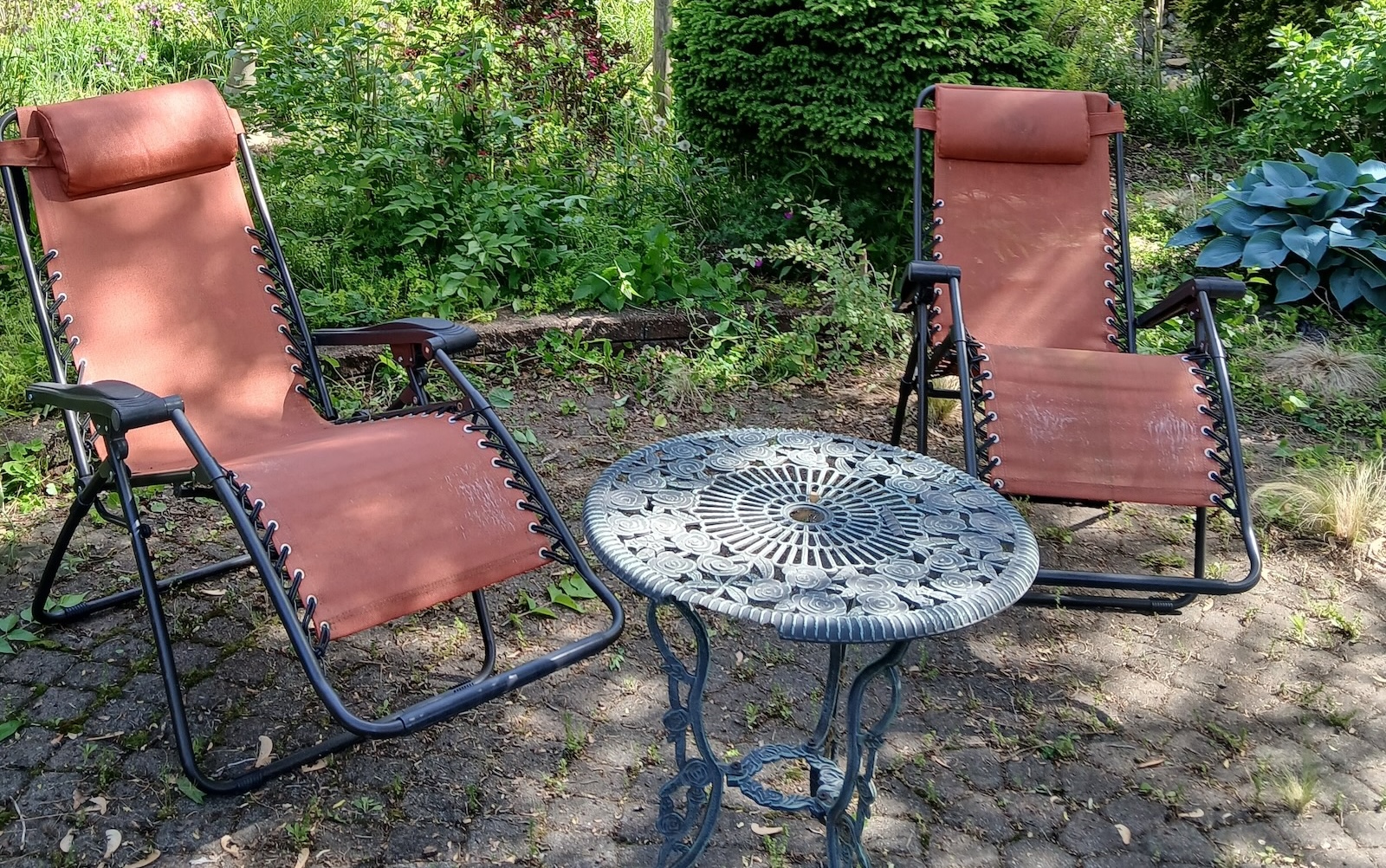Vacated Lawn Chairs by Miriam Bat-Ami

Photo by Miriam Bat-Ami
Since my husband’s death in March of 2020, I’ve gotten into the habit of counting chairs on front porches and lawns, in backyards and around firepits, vacated seats suggesting a grouping of two or more: a husband and a wife relaxing after dinner while the children run from the swings to the slide or couples drinking wine at the close of the day. I have walked freely alone among the forested trees, but lawn chairs call for company. They remind us of crowded beaches and outdoor concerts, of church and synagogue picnics, of family gatherings, and of elderly couples seated side by side as they read. There are three such chairs in my back yard: orange sling affairs that are hard for an older person to navigate. You must let your body fall into the seat. You can’t fear the loss of balance.
For five years, I’ve considered the passage of time in terms of lawn furniture that my husband Ron and I owned beginning with colorful flimsy aluminum chairs that we could move around easily. Vagabonds of the exterior design world, they made their seasonal journey out of storage when Aaron, our eldest son, and Danny, three years his junior, had soccer, baseball, and cross-country events or when we embarked on the annual family visit to a Lake Michigan state park. On July fourth nights, we threw the deteriorating chairs in our just as deteriorating pick-up along with blankets, coolers, and water bottles. Packed in school playgrounds or beaches with other families, we stared up at the Michigan night sky while firecracker rain drops dissolved above us.
When our children were still young and loved playing in the backyard of the first home that Ron and I owned, we bought sturdier outdoor furniture that we lugged out of winter hibernation in a corner of the cellar. The grey-painted folding picnic table became a back porch fixture. Evenings, Ron moved back and forth from the Little Pal barbecue to the table. I sat grading my unending supply of student papers as first Aaron and then Danny practiced hopping and skipping, two necessary prerequisites for passing out of kindergarten into first grade. The boys shared their own orange and yellow plastic table.
Some years later, the purchase of a wrought iron table, six accompanying chairs, and an outdoor umbrella marked our familial ascent into economic stability. I had gotten tenure at Western Michigan University. Ron and I received a loan for our second larger home. Our sons had their own bedroom on the first floor. Ron and I slept on the second. We became a settled family that lived in the same place all through our sons’ schooling and through the years when they attended and graduated from college. Wrought iron lasts for decades. Our chairs and table stayed put while we replaced the tattered umbrellas.
At least ten of us congregated round the faithful well-used table and chairs in the fall of 2017. We pulled out extra chairs from inside the home, gathered flowers into buckets of water and stuck blossoms into green Styrofoam rectangles that had been squeezed inside wooden table settings. Danny was getting married the following day. Scissors in hand, searching out wedding-worthy blossoms, I moved back and forth between the beds of dahlias, sunflowers, and zinnias that I had planted for this event. My chickens pecked at tomato bushes adjacent to the flowers and snacked on fallen sunflower seeds.
These chickens, like our latest dog and cat, came into our lives several years after our sons went off to college and started their own lives with their own lawn furnishings. The “girls,” as I liked to call my hens, took turns sitting on the wrought iron table and chairs while my husband and I ate breakfast at the kitchen table near the glass back door. Often, they perched on the arm rests and tilted their heads to the sun like feathered flowers. Sun-baked and perpetually starving for food and attention, they hopped over to the sliding door, tapped at the glass with their beaks, and reminded me, their provider, that hens, too, have their needs.
Late afternoons, when the weather was just the right temperature for sitting, Ron and I, now aging empty nesters, parked ourselves under the one backyard shade tree and cast our eyes to the endless horizon while our rusted charcoal grill, a replacement for the much more dependable Litle Pal, sent up smoke signals to some silent entity above us. The chickens scratched near our feet and let out chirping sounds when they discovered a worm or grub.
Two years after Danny’s wedding, my husband and I sold that second home where our children spent the majority of their growing up years. Ron had trouble navigating the stairs. I did not want to be reminded of vacant lawn furniture, basketball hoops that had fallen into disuse or rooms that had transformed from the kids’ bedrooms to our studies. We decided to downsize and start a new life. The wrought iron table and chairs went to a young couple with a child and a dog. Four lawn chairs became two that I kept in the garage and, despite all logic, moved into a POD that would follow us as soon as we knew exactly where we’d live. Like the disreputable chairs, we became vagabonds who traveled all the way to New Mexico with our dog. My best friend, always a sucker for displaced animals, fostered our cat and the chickens while we embarked on house hunting. Ultimately, Ron and I decided that, really, although born on the East coast, we had become devoted Michiganders who could not survive without being near some decent body of water.
Thus, in October of 2019, my husband, the dog, and the cat moved into our third home about forty miles away from the old domicile and much closer to Lake Michigan. The large autumn leaves on the front yard’s massive sycamore fell without abating. Between raking and bagging, I decided to buy an orange sling chair so I could enjoy the beautiful garden that seemed like a gift and made my leaving the apple and peach trees more bearable. I had no desire for sturdy outdoor furniture that would outlive both me and Ron. The orange reclining chair, a small patio table, and four metal chairs seemed enough.
Liking my chair and its low price, Ron ordered a second in red until I remarked, “Don’t you think we should have two orange chairs and not one in orange and one in red?” I forgot that a color-blind man has a skewed perception of some colors, although I’ve been reminded by my father, husband, and son that inaccurate color identification is compensated by a keen awareness of the size and shape of things. We ordered two more orange chairs to accompany the one that I had bought. Surely, we’d entertain visiting friends and family who would be drawn to our place near the beach. The two ragged aluminum lawn chairs leaned against the corner of our new garage waiting for fireworks or a beach outing.
When we sat together, parked near family and friends, I felt safe, as if all that side-by-side coming together called forth ancient memories of fire pits and community circles. Since Ron’s death, I have not been afraid of anyone robbing me or anyone entering my home and assaulting me, but without my husband, I have felt like one chair on the front porch, a solitary entity unsafe in its lone being. So, I welcome the man who comes to visit me. I line up two of the three orange sling chairs side by side, knowing we will sit together. For the days that he’s with me, this man who is not my husband will make me feel still single, still a widow, but safe.
And yet, after his visit, my soul aches to be near that man who has been beside me for nearly forty-four years, so I travel to the cemetery with the surviving lawn chair—mice ate away at the second—and I draw close to my husband. The solo chair finds its place on the grass between graves.
 A retired Western Michigan University English professor, Miriam Bat-Ami has published one picture book (Sea, Salt, and Air, Macmillan), two middle grade novels (When the Frost is Gone, Macmillan, and Dear Elijah, Farrar), plus a YA historical fiction (Two Suns in the Sky, Front Street/Cricket) that won the Scott O’Dell Award. She was the Grand Prize Winer of the Maine Media Workshops and College Deams contest for her “A Rounded Bowl” (prose poem) that later became part of her published volume of poetry (Measuring the Marigolds, Caffeinated Press). Most recently, “Flight” (a literary tale) was published in Ember. Numerous prose poems appeared in The Mackinaw: A Journal of Prose Poetry, and Persimmon Tree published “Once Upon a Rhythm” (poem) and a short take. Some of the aforementioned plus “Vacated Lawn Chairs” are part of the multi-genre manuscript “The Naked Sycamore.” Bat-Ami is a proud grandmother of two girls and a boy. She enjoys hiking, gardening, and swimming and sees her lawn chairs as invitations to communal joy.
A retired Western Michigan University English professor, Miriam Bat-Ami has published one picture book (Sea, Salt, and Air, Macmillan), two middle grade novels (When the Frost is Gone, Macmillan, and Dear Elijah, Farrar), plus a YA historical fiction (Two Suns in the Sky, Front Street/Cricket) that won the Scott O’Dell Award. She was the Grand Prize Winer of the Maine Media Workshops and College Deams contest for her “A Rounded Bowl” (prose poem) that later became part of her published volume of poetry (Measuring the Marigolds, Caffeinated Press). Most recently, “Flight” (a literary tale) was published in Ember. Numerous prose poems appeared in The Mackinaw: A Journal of Prose Poetry, and Persimmon Tree published “Once Upon a Rhythm” (poem) and a short take. Some of the aforementioned plus “Vacated Lawn Chairs” are part of the multi-genre manuscript “The Naked Sycamore.” Bat-Ami is a proud grandmother of two girls and a boy. She enjoys hiking, gardening, and swimming and sees her lawn chairs as invitations to communal joy.
